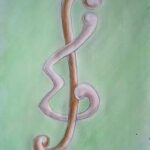
A
The basis number of a graph
A set
This paper presents a computationally efficient algorithm for solving the following well-known die problem: Consider a “crazy die” to be a die with
Difference systems of sets (DSS), introduced by Levenshtein, are used to design code synchronization in the presence of errors. The paper gives a new lower bound of DSS’s size.
In a loop transversal code, the set of errors is given the structure of a loop transversal to the linear code as a subgroup of the channel. A greedy algorithm for specifying the loop structure, and thus for the construction of loop transversal codes, was discussed by Hummer et al. Apart from some theoretical considerations, the focus was mainly on error correction, in the white noise case constructing codes with odd minimum distance. In this paper, an algorithm to compute loop transversal codes with even minimum distance is given. Some record-breaking codes over a 7-ary alphabet are presented.
Let
For the graph
We investigate
Let
We define 1 new type of resolvability called
Recent developments in logic programming are based on bilattices (algebras with two separate lattice structures). This paper provides characterizations and structural descriptions for bilattices using the algebraic concepts of superproduct and hyperidentity. The main structural description subsumes the many variants that have appeared in the literature.
The Ramsey number
Comma-free codes are used to correct synchronization errors in sequential transmission. Systematic comma-free codes have codewords with fixed positions for error correction. We consider only comma-free codes with constant word length
This paper gives the exact size of edit spheres of radius 1 and 2 for any word over a finite alphabet. Structural information about the edit metric space, in particular a representation as a pyramid of hypercubes, will be given. The 1-spheres are easy to understand, being identical to 1-spheres over the Hamming metric. Edit metric 2-spheres are much more complicated. The size of a 2-sphere hinges on the structure of the word at its center. That is, the word’s length, number of blocks, and most importantly (and troublesome) the number of locally maximal alternating substrings (LMAS) of each length. An alternating substring switches back and forth between two characters, e.g. 010101, and is maximal if it is contained in no other such substring. This variation in sphere size depending on center characteristics is what truly separates the algebraic character of codes over the edit metric from those over the Hamming metric.
We determine some coefficients of the flow polynomial of the complete graph
Groups provide the mathematical language for exact symmetry. Applications in biology and other fields are now raising the problem of developing a rigorous theory of approximate symmetry. In this paper, it is shown how approximate symmetry is determined by a quasigroup.
A graph has the neighbour-closed-co-neighbour, or ncc property, if for each of its vertices
In this paper we obtain some necessary conditions for the existence of balanced arrays (B-arrays) with two symbols and having strength seven. We then describe how these conditions involving the parameters of the array can be used to obtain an upper bound on the constraints of such arrays, and give some illustrative examples to this effect.
A defensive alliance in a graph
We discuss a branch of Ramsey theory concerning vertex Folkman numbers and how computer algorithms have been used to compute a new Folkman number. We write
By analogy with Stirling numbers, tri-restricted numbers of the second kind count the number of partitions of a given set into a given number of parts, each part being restricted to at most three elements. Tri-restricted numbers of the first kind are then defined as elements of the matrix inverse to the matrix of tri-restricted numbers of the second kind. A new recurrence relation for the tri-restricted numbers of the second kind is presented, with a combinatorial proof. In answer to a problem that has remained open for several years, it is then shown by determinantal techniques that the tri-restricted numbers of the first kind also satisfy a recurrence relation. This relation is used to obtain a reciprocity theorem connecting the two kinds of tri-restricted number.
1970-2025 CP (Manitoba, Canada) unless otherwise stated.